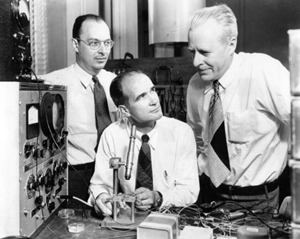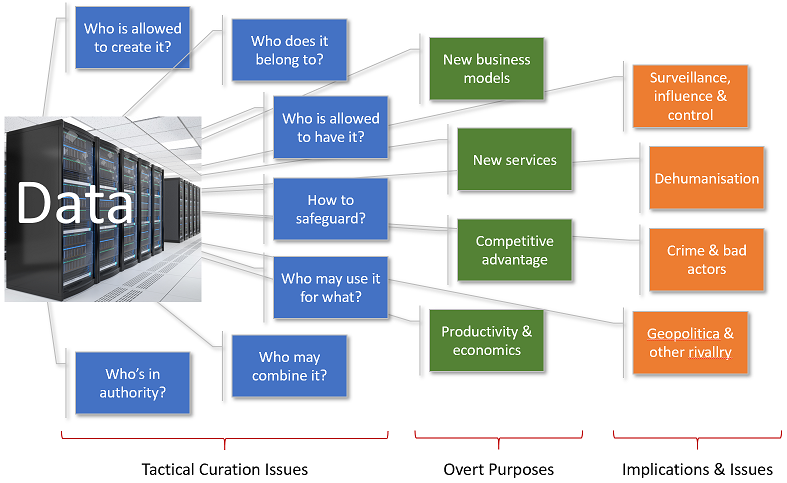Last Updated on
Digitalisation is a big subject now, yet it is growing fast in importance and reach.The implications are considerable now, for business and beyond, and few decision makers can ignore the potential impact.
It’s the Data
At the core of digitalisation is the data – the stuff that makes it all possible. Digitalisation is nothing without data of some sort. Understand the data and you understand the issues.
For most decision makers, there are tactical issues immediate to the data (Blue), there are the obvious, direct, overt purposes to which it can be put (Green), and then there are the cover purposes, the more malign uses, and the inadvertent implications (Orange).
Active perspective
 Digitalisation is a moving target, an evolving picture, with echoes back in the Nineteenth Century, but arguably kick started by Bill Shockley at Bell Labs in 1945. Since then, the march of digitalisation has been gathering speed and penetrating all aspects of society and beyond, with the help of Andy Grove and others now too numberous to mention.
Digitalisation is a moving target, an evolving picture, with echoes back in the Nineteenth Century, but arguably kick started by Bill Shockley at Bell Labs in 1945. Since then, the march of digitalisation has been gathering speed and penetrating all aspects of society and beyond, with the help of Andy Grove and others now too numberous to mention.
The pace of innovation and change is such that perspectives become out of date quickly, and anyone looking ahead must keep looking. So I present here an active perspective where I can. Here’s a list of my blogs on Digitalisation, and I add to them as I see the leading edge move significantly, or about to.
Worthwhile background reading:
Big Tech takes aim at the low-profit retail-banking industry.![]() Silicon Valley giants are after your data, not your money. After years of timidity Big Tech, with its billions of users and gigantic war chest, at last appears serious about crashing the Fintech party.
Silicon Valley giants are after your data, not your money. After years of timidity Big Tech, with its billions of users and gigantic war chest, at last appears serious about crashing the Fintech party.
![]() Antitrust and the intrinsic value of Alphabet In this post Jeff Henriksen, co-founder and CEO of Thorpe Abbotts Capital, explores how Google has grown to dominate the digital advertising business, and what impending regulation might mean for its core assets.
Antitrust and the intrinsic value of Alphabet In this post Jeff Henriksen, co-founder and CEO of Thorpe Abbotts Capital, explores how Google has grown to dominate the digital advertising business, and what impending regulation might mean for its core assets.
Ubiquitous computing: Drastic falls in cost are powering another computer revolution ![]() The magic of computers is that they provide in a machine an ability—to calculate, to process information, to decide—that used to be the sole preserve of biological brains. The IoT foresees a world in which this magic becomes ubiquitous. Countless tiny chips will be woven into buildings, cities, clothes and human bodies, all linked by the internet. Like most futures, a lot of the IoT is already here—it is just not (yet) evenly distributed.
The magic of computers is that they provide in a machine an ability—to calculate, to process information, to decide—that used to be the sole preserve of biological brains. The IoT foresees a world in which this magic becomes ubiquitous. Countless tiny chips will be woven into buildings, cities, clothes and human bodies, all linked by the internet. Like most futures, a lot of the IoT is already here—it is just not (yet) evenly distributed.
![]() Artificial Intelligence and the Future of Humans Digital life is augmenting human capacities and disrupting eons-old human activities. Code-driven systems have spread to more than half of the world’s inhabitants in ambient information and connectivity, offering previously unimagined opportunities and unprecedented threats. As emerging algorithm-driven artificial intelligence (AI) continues to spread, will people be better off than they are today?
Artificial Intelligence and the Future of Humans Digital life is augmenting human capacities and disrupting eons-old human activities. Code-driven systems have spread to more than half of the world’s inhabitants in ambient information and connectivity, offering previously unimagined opportunities and unprecedented threats. As emerging algorithm-driven artificial intelligence (AI) continues to spread, will people be better off than they are today?
![]() The Trust Opportunity: Exploring Consumer Attitudes to the Internet of Things This study aimed to get a sense of consumers’ attitudes to privacy and security when it comes to connected devices and explore to what extent consumers trust connected devices. Our other objectives were to understand what matters to consumers when buying connected devices and where they feel that the responsibility for better security and privacy lies.
The Trust Opportunity: Exploring Consumer Attitudes to the Internet of Things This study aimed to get a sense of consumers’ attitudes to privacy and security when it comes to connected devices and explore to what extent consumers trust connected devices. Our other objectives were to understand what matters to consumers when buying connected devices and where they feel that the responsibility for better security and privacy lies.
![]() How to hack your face to dodge the rise of facial recognition tech As the use of FR becomes more prevalent in the places we move through in our daily lives, the concerns associated with it become sharper. Until the sticky wheels of regulation grind into gear, what are the options for people who want to walk around in public without being constantly identified?
How to hack your face to dodge the rise of facial recognition tech As the use of FR becomes more prevalent in the places we move through in our daily lives, the concerns associated with it become sharper. Until the sticky wheels of regulation grind into gear, what are the options for people who want to walk around in public without being constantly identified?
AI is being taught by thousands of office workers BHUBANESWAR, India — Namita Pradhan sat at a desk in downtown Bhubaneswar, India, about 40 miles from the Bay of Bengal, staring at a video recorded in a hospital on the other side of the world. The video showed the inside of someone’s colon. Ms. Pradhan was looking for polyps, small growths in the large intestine that could lead to cancer. When she found one — they look a bit like a slimy, angry pimple — she marked it with her computer mouse and keyboard, drawing a digital circle around the tiny bulge. She was not trained as a doctor, but she was helping to teach an artificial intelligence system that could eventually do the work of a doctor
BHUBANESWAR, India — Namita Pradhan sat at a desk in downtown Bhubaneswar, India, about 40 miles from the Bay of Bengal, staring at a video recorded in a hospital on the other side of the world. The video showed the inside of someone’s colon. Ms. Pradhan was looking for polyps, small growths in the large intestine that could lead to cancer. When she found one — they look a bit like a slimy, angry pimple — she marked it with her computer mouse and keyboard, drawing a digital circle around the tiny bulge. She was not trained as a doctor, but she was helping to teach an artificial intelligence system that could eventually do the work of a doctor
More on this subject
| First Page | Previous Page | Next Page | Advisory |
 |
 |
 |
 |
Blogs on: Strategy, Trends, Management
Also Interesting Reading
Peter is chairman of Flexiion and has a number of other business interests. (c) 2019, Peter Osborn
